| This article has been grammatically checked and corrected by the Online software Grammarly. This article was last edited by Montivagant (talk| contribs). (Update) |
| The Trinitarian Parliamentary Republic of Liberta Liberta, Libertae | |||||
|---|---|---|---|---|---|
| |||||
|
Motto: Libertas. Scientia sit potentia Freedom. Knowledge is power. | |||||
|
Anthem: People of the Sea | |||||
 | |||||
| Capital and largest city |
Liberta (city-state) | ||||
| Official languages | Latin | ||||
| Recognised languages | Greek, Moroccan Berber | ||||
| Recognised national languages | English, Oro, Eerie | ||||
| Ethnic groups | Libertans, Americans, Europeans | ||||
| Religion | Atheist Majority | ||||
| Demonym | Libertan | ||||
| Government | Devolved Trinitarian Parliamentary Republic | ||||
• Potissimus |
Lawson Guus | ||||
• Potissimus |
Marino Laurens | ||||
• Potissimus |
Gaius Destin | ||||
• Vice Potissimus |
Clarance Austin | ||||
• Vice Potissimus |
Agusto Cees | ||||
• Vice Potissimus |
Corrin Jost | ||||
• Mayor |
Loran Marcin | ||||
• Vice Mayor |
Lev Ignacio | ||||
| Legislature | Parliament | ||||
| Hall Of Decision | |||||
| Events of National Importance | |||||
• Founded |
80 BC | ||||
• Sovereignty |
19 BC | ||||
• Trinitarian System Founded |
36 AD | ||||
• Trinitarian System Fully Executed |
60 AD | ||||
• Libertan Navy Founded |
130 AD | ||||
• Defense-walls finished |
154 AD | ||||
• Battle of Unda |
524 AD | ||||
| Area | |||||
• Total |
133 km2 (51 sq mi) | ||||
• Land |
51 sq mi (130 km2) Only City of Liberta | ||||
• Water |
203,252 km2 (78,476 sq mi) Nautical Territory | ||||
• Water (%) |
99.6 | ||||
| Population | |||||
• Estimate |
3,000,000 | ||||
• 2010 census |
3,000,000 | ||||
| GDP (PPP) | 2016 estimate | ||||
• Total |
$650 billion (20th) | ||||
• Per capita |
216,666 (1st) | ||||
| Gini (2008) |
0.34 low | ||||
| HDI (2015) |
0.950 very high · 1st | ||||
| Currency | Equal Dollar (EQD) | ||||
| Time zone | AZOST (UTC-1) | ||||
| Date format | YY-MM-DD | ||||
| Drives on the | right* | ||||
| Calling code | +83 | ||||
| Patron saint | Saint Ace | ||||
| ISO 3166 code | LIOF | ||||
|
Website liberta.gov.lb | |||||
| |||||
The Trinitarian Parliamentary Republic of Liberta (/lɪbɛrtɑ/) is a city-state located in the Atlantic Ocean, laying on the Great Meteor Seamount with a devolved Trinitarian System of Government. Liberta lies west of the Moroccan coast and south-west of the Iberian Peninsula. Its capital and only city is the City of Liberta and amasses for 96,99% of the total landmass of Liberta. The fauna of Liberta solely consists of megafaunal taxa of corals, sponges and sea urchins, together with 53 different species of fish, all originating from the seamount[1].
While Libertas land area is significantly minuscule in comparison to other countries in southern Europe, it has a nautical territory of 203,252 km2, in which it also occupies Hyéres and Plato Seamounts, and Cruiser Tablemount . These areas have been subject to multidisciplinary research. Liberta solely consists of the city of Liberta itself, together with “defense-walls” or breakwaters and McGarrett island (solely built for the construction of McGarrett International).
The Trinitarian Parliamentary system is unique to Liberta, where it is fully executed. The system works in partial terms of a parliamentary republic and consists of one chamber, being the "hall of decision" in the City Hall of Liberta. In the hall of the decision, there would be 100 men called the cardinalises, these men where to be elected locally each fifth year, parallel to the potissimuses, three men that together are the head of government and state. Another way to compare the trinitarian parliamentary system is by thinking of the cardinalises as the chamber and the potissimuses as the presidents since that are the actual roles they are executing.
In the international community, Liberta is seen as a an economic and cultural center, as well as so called "gate" to Mediterranean culture. McGarett International Airport is the worlds largest airport in amount of passengers per year, and serves as a major hub for over 30 airlines. As such, Liberta is an attractive tourist location, due to its well preserved Ancient Greek, Byzantine, and Romanesque architecture, as well as for its rich historical aspects of the country.
History[]
Ace Aquarius was the son of Argento Aquarius. Argento Aquarius was a very powerful man, he had a large influence over Greek politics and owned many mines in Greece and Italy. After his father died, Ace realized how cruel he thought the Roman Empire was, and how its political systems were horrible and ineffective. Ace quickly took over his fathers remains, including his mines.
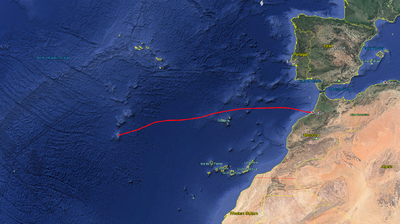
The journey marked in red.
He decided that he would flee from the Roman Empire. After visiting Crete, Ace started building large cargo ships, he ordered 150 men working in the mines to go with him on Aces own boat “Aquaria”. After sailing to Morroco he headed southwest. After several days of traveling, out of sheer coincidence, he saw large bubbles erupting from the sea. He ordered his men to hoist down large stone blocks, each attached to a tight
rope between each other. After 200 stone blocks were hoisted down, then a small part of the rope lay on the surface water indicating a shallow seabed. After two hours the 180 large cargo ships following Aquaria had arrived to next to the shallow seabed. The shallow seabed was, in fact, the Great Meteor Seamount. Ace ordered all of the cargo ships to hoist down large stone blocks, just like he had done. The 180 boats made a circle formation approximately 5000m in circumference. Since all of the cargo boats hoisted down the around 200 stone blocks, it created the shape of a cylinder with all of the stone blocks. After this long process was finished, Ace left 20 boats on the location and sailed back to Morroco where he called for more stone bricks via a messenger boat. He then ordered that 20 boats were to sail back to the other 20 boats at the stone cylinder. This process was to be repeated every third day.
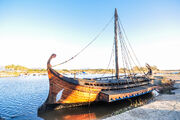
Similar boats were used.
After Ace had spent around 2 months in Morocco 240 cargo boats with stone blocks had arrived. Ace immediately set course back to the Stone cylinder. After arriving at the location, the 240 boats started hoisting down large amounts of stone blocks within the stone cylinder. After two days the process was completed. Ace built houses and streets on the small plateau that he had made. He declared it a nation, and Ace’s son Baptiste was appointed the successor to his fathers new-made land. The “nation” was mostly a puppet play of a society. Ace only invited his family to come to the “nation” and nobody else. The “nation” was not a fully working one under Ace’s rule.
When Ace died his son Baptiste was appointed a king of the island, however, Baptiste had bigger plans. He ordered 24 200 meter long cargo boats to be built, each day 1 boat would leave from Athens to the “nation”. This way a new boat would arrive at the “nation” every day since the travel time was around 22 days.
Baptiste named the small nation to Liberta, presumably from the Latin word for liberty. As Liberta grew, Baptiste set out to find peasants that were willing to live in Liberta. He ordered 12 men to travel to Greece and find these peasants. After 2 years the men returned with 2000 people on smaller ships. All of these 2000 people were given citizenship to Liberta. Baptiste ordered 40 more men to find 10 000 people around Europe for a larger payment. Under the 8 years, it took for the forty men to find 10 000 people Baptiste had made stone cylinder much larger using the same technique as his father. When the men returned with 10 000 people they were immediately given citizenship. Baptiste built libraries, schools or as he wished to call them “educational facilities”, he stamped a common currency for all of Liberta to use, he built for the time advanced water treatment facilities. Baptiste died in 9 BC for unknown reasons, most likely from leprosy.
Baptiste had a son, Cato. Cato was the age of 19 when his father died. He was very shy as a child, however, he became the man that would forever change Liberta. Cato was a poet with a strong interest in politics. He saw the flaws with the monarchy, the system that his father had used and grandfather had established on Liberta. Cato imagined a system much like a modern-day representative democracy. He ordered to build a giant city hall. After 2 years the hall was finished. Cato decided that three men were to rule Liberta together. These men were to be elected by all citizens every 5 years. There would be 100 people who would vote on different issues. The 100 people would be elected by regional voting in each of Libertas districts and be called Cardinalises. These 100 people would represent different opinions (that they themselves would choose) and would then be elected by the residents of that neighborhood. This would happen every five years. The Cardinalises would then present the different issues that they had voted on. These different issues were designated by the residents of each district (several neighborhoods geographically next to each other). After the Cardinalises had voted on these issues the ones that passed through the majority decisions the issues would then be brought up to the three leaders of Liberta (known as the potissimuses). Either the Potissimuses accepted and let the issue be made a formal proposal (with cost and possibility taken into consideration), vote for an “excuse” (a significant change tweak on the issue) or they rejected and abandoned the issue completely.
Before the change fell into action he decided to make the 15 principles, now known as the Libertan Constitution.
Parts of this political change fell into action 4 years after the city hall was completed, Cato however, appointed himself ruler until he died. The Potissimuses-Cardinalises system was still running and working under Cato’s rule. Cato had a fascination for Taggiasca olives and made a small park where he planted many olives trees. Cato died in 59 AD, from age. He had left a son under his rule, Konstantin. Konstantin never had any political influence however, he still owned all of the mines in Greece. Konstantin sold all of his father's mines to the Libertan State for 40000 equal coins. He used that money to live in luxury. Konstantin was a poet, and never intended to follow his father’s passion for politics, instead, he spent most of his life as a writer. At the age of 70, he died from an epilepsy attack.
130 – 200 AD[]
As the population of Liberta grew, so did the manmade island that Liberta stood upon. The small island grew from an area closer to 2km2 to an area about 8km2. The Cardinalises voted for an idea to put large stone walls, or breakwaters if you will and stood around 2 km outside of the city. The issue passed and was signed by the Potissimuses. At the same time, Liberta started ordering their cargo ships to return back to Liberta. However, two cargo ships a day left for Athens and arrived at Libertas harbor. After a cargo ship had been plundered Liberta only allowed one cargo ship to leave for Athens each second day. The Potissimuses decided that for Liberta to respected internationally they needed a military force. Out of that idea became the Libertan Navy, known for their fierce warfare on their Navibus Ignem ships. The Libertan army only consisted only of the navy, who only focused on maritime warfare. Since the 15-principles did not allow offensive warfare, the building of the giant stone walls 2 kilometers outside the island was accelerated. The walls stood finished 154 AD and gave the navy a significant upper hand in case of an attack. As military pride began to rise so did patriotism. As patriotism rose so did Libertas national identity, knowledge was considered a powerful weapon and with it came the first standardized school curriculums. As literacy was obligatory, for every child under 10 years of age the schools were even more standardized and featured several subjects and designated times. The first real subjects you could study towards were arts, economics, and politics.
200 - 500 AD[]
Libertas population had now increased to over 120000 people at an area of around 16 km2. As trade had shrunken over the 3rd-century, so had diseases from Europe. Liberta had the luck of incredibly low infection rates thanks to the separation between clean water and wastewater. Because of this Liberta experienced a baby boom. Between 238-256 AD the rate of babies being born doubled. This, in turn, led to a massive population increase, which led to an expansion of area, something the Libertan Government did not want. Strategically, the sudden expansion was horrible, since the city border came closer to the defense walls, meaning an increased vulnerability to outer forces. The defense ministry started petitioning for a larger stone wall, a wall 18 meters in length instead of the previous 6 meters. The issue fell into order in 288 AD according to the Magno Vicipaedia .
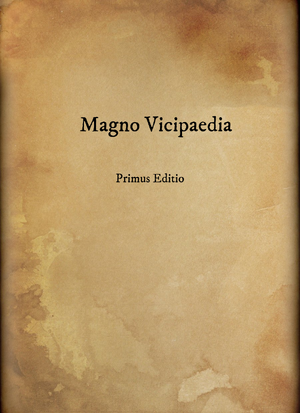
The first page of the first edition of Magno Vicipaedia.
During the start of the 4th-century citizens as well as cardinalises started taking notice of the difficulty of owning, raising and keeping cattle. These issues had largely been ignored, however, in 302 AD Lucjuzs Octavio had taken notice of sicknesses plaguing the farmers. Because of this the farmers and their animals were sent to the defense walls around the city to not infect other citizens. The grass was planted on the plain side of the defense walls so that the animals could feed. Before these animals were only kept in smaller enclosures around the city. Olive trees were also soon planted on plain sides of the defense walls, as well as other trees, plants and vegetables. In October of 322 AD, a large storm hit Liberta. Windspeeds were reportedly high to extreme and whole trees and houses were torn down. After the calm had settled the defense ministry called for even more spending on reinforcement of the defense walls, something that the government approved – with a small margin.
As morale in the Libertan identity had shrunken several large parades showing a strong, unified and a militarily strong Liberta, the truth wasn’t much different. Liberta had a small manpower, but technically advanced boats, weapons, and armor, morale within the military was significantly high. Since Liberta was a small country, it could not only afford to pay more per soldier but also more on weapons and armor. The armor consisted of a mixture of bronze and iron chest plate, a tangerine-gold colored helmet that consisted of iron, gold, and copper, a greave around the whole leg, a neck-protecting piece of armor connected to the chest plate. Arm-protecting sleeves made of copper, iron, and gold were specifically designed to fit each individual soldier. Advanced and sharp spears were constructed, which often had two small bird-like wings attached to the spearhead which gave better precision and longer throwing distances. Large, thin, and carefully decorated swords were often carried on the dominating side of the hands, together with a shield connected to the arm-protecting sleeves on the non-dominating side of the hands. The soldier's shoes were also carefully fitted for each individual soldier and were made by equipping sandals with a tight leather skin around them. On the top of the helmet, the Libertan Circle was put. The armor was easy to take off so that hurt soldier would easily and quickly be taken care of, and soldiers fallen in the water easily could swim to safety without any additional weight. In Liberta, the soldiers, as well as the military, were celebrated as brave and “savers of freedom”. The military wasn’t obligatory and so many people wanted to join it, it was something children looked up to and wanted to one day become. The military became a protection and the soldiers the role models. Ancient archeologic findings show catch-words of the military written by people on houses and in alleys. Liberta was not a military state, however. Upon all, the most celebrated subject by Libertan citizens and politicians was knowledge. “Knowledge is power” is written on the banner of the national seal on top of the roof of the city hall, the national libraries and on the first ever temples in Liberta. Quentin Salvadore, a famous potissimus once said: “Knowledge of the world is not to be interfered by the religious beliefs”, and therefore religion never played a big part of the Libertan society, especially in the 4th and 5th-centuries. This very quote is what was the founding of the ideology today known as Liberism.
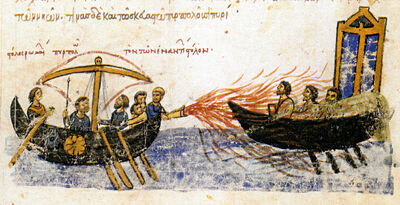
The Libertan Navy.
500 - 700 AD[]
After bad diplomatic relations with the Byzantine Empire, the Byzantine Navy attacked Liberta in the year 524. Libertas army, however, had the upper hand. What is now known as the battle of Unda had begun.At four in the morning a coastguardboat was performing a regular guarding-cruise around 4,3 nautical miles (8km) from the Libertan breakwaters when several large ship was spotted at 3 or 4 nautical miles away. Because of a security measure put in place 341, all coastguardboats must carry a smaller boat with retractable sails as this was the quickest known way to report infomartion back to the coastguard headquarters on land, this small sailboat was released to report back to the headquarters that large Byzantine Ships had appeared in nautical territory. At 5 o’ clock 400 soldiers had been sent out to the east breakwater, as the ships came closer 13,000 more had been sent. Weeks of isolation had morally and psycologically weakend the Byzantine Troops significantly. Because of miscalculations by an officer, the infantry arrived the 6 in the morning, instead of 8-9. However, this was a disadvantage for both sides as battling in the dark affected everyone's sight. Desperate soldiers swimming for their lives, eagerly trying to get to shore. Many of whom died by the dawn. Of the 10000 byzantine men sent only 500 managed to escape death and Libertas deadly shores. The Libertan Army had seen little to no casualties. Of the 14000 Libertan soldiers, there were reports of only a 900 dead. Shortly after these Libertan diplomats sought to seek peace with the Byzantine Empire, which shortly thereafter happened. Because of the loss of 9500 men, Liberta had to pay by giving the Byzantines 1 large and expensive cargo boat.
The Apathetic Years[]
By the end of the 7th-century, Liberta had a population of 200000 and constantly growing. Liberta became known for their excellence in educational facilities such as the Vidal Universitates, the foundation of modern-day Universities. This “blossoming” of academic institutes were later given their own period, known as the Libertan apathetic years. This was a combination of peace-ideology and romantic nationalism. Under these years famous academic institutes were founded, such as Kolm University, Gaius University, and the school of Cato. In 758 the banning of owning slaves was brought into action. The rumor of Liberta being a country with endless education and luxury was spread through Europe. Liberta became a sanctuary for slaves being mistreated if any of them ever had the chance, the few ones being able to sneak into cargo boats, hide in boxes or just pay their way to Liberta were granted citizenship.
1000 – 1500 AD[]
The Libertan apathetic years ended in 1000 AD, and so begun the Libertan Medival Era. As diplomacy between the Byzantine Empire and Liberta became even more steady, so did their alliance. As the 15 principles (comparable to a nations constitution) prohibited the navy from actively participating in wars in an offensive role the navy instead sent several large warships to the Byzantine Navy, these were known to be quick and effective. These were mainly used in the Byzantine–Arab war, the Byzantine–Bulgarian war, the later Rus–Byzantine wars and the Byzantine–Norman war.
Liberta was a valuable resource to many countries, as it allowed for naval contact with Morroco from the east. Liberta was seen as a checkpoint, if Liberta was taken under control by a foreign empire then that would allow for the naval control of the Moroccan, Iberian and French coastline.
For many empires, however, Liberta was out of reach.
Liberta successfully avoided the plague in part because of geographical distance from Europe. This is why Libertas population kept growing while many other countries population fell.
1500 – 1700 AD[]
As the first Greek migration occurred the Greek intelligentsia fled to western Europe. Many of the also fled to Liberta. Liberta regained its reputation for excellence in education during the 17th-century. The “the big three” (Kolm, Gaius University and school of Cato) and the whole of the Libertan educational movement weren't affected by the scientific oppression during the renaissance, partially because of the ideology of Liberism. Historians agree that distance from Europe played a large part in avoiding the scientific oppression as well.
During the age of discovery, Liberta became an important “key” to the Atlantic and served as a checkpoint for ships sailing towards other continents. Since slaves were illegal in Liberta, disguising ships as merchant ships became popular, as well as underground harbors where slave ships could arrive at a high fee. Otherwise ships had to avoid Libertan nautical territory, sometimes slaves jumped overboard and tried to swim to shore, as some slave ships still came dangerously close to the city itself.
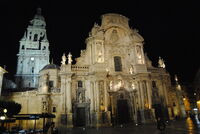
The war memorial at night.
As friendly relations with the Sharifate of Marrakesh increased so did the influence of Morrocan culture. This is the age that the Water Palace was built to symbolize friendship between the two nations. This short period of time between 1650 and 1700 is known as “the age of friendship”.
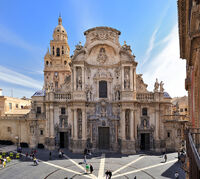
Central view of the war memorial. Built in the 16th century. The clocktower was added a century later.
1700's – 1940's[]
While many countries fought each other during the Renaissance, Liberta enjoyed the significant distance from the European continent, as war often plagues a nation’s economy. In direct consequence of the Libertan Neutrality Pact of 1748, a continuation of the defense-oriented tactics appointed by the constitution Libertas economy flourished. In 1732 tithing became illegal in Liberta as the state didn’t want interference with taxation and citizens not being able to pay their taxes. In 1756 the first ever effective tariff was introduced under the Latin name “Lezdam” by the government, with notable backlashes led by traders. This tariff improved the government’s income, which led to the Religious Assemblies Compensation Act of 1788, effectively compensating the lost income to religious assemblies as a consequence of the ban on tithing. In early 1809 the Religious Assemblies Compensation Act was reformed into the Exemption of Taxes for Religious Assemblies Act, effectively exempting Income and Property taxes for Religious Assemblies. During this period. During the 1700's the Second wave of Romantic Nationalism started, the slow refinement of Libertan culture and national identity. It was during the 1700's that the upper-class mostly centered in Oriens grew. As Liberta became more accepted in the international community. It was also during the 18th century that the now well-known self-dependence ideas really started to grow. This is what started the now current so-called "self-thinking method" that is traditionally included in modern-day Libertan politics, that is that the current goal of the Libertan Government and State is to avoid alliances which would result in military or political alliances. The current only officially recognized trade- and economic alliances are with the United States. Although this excludes the order of 100 JAS 39 Gripen Fighters from Sweden. Otherwise, the Government of Liberta usually considers having small bonds with other neutral powers, such as Switzerland and Sweden. The industrial revolution completely changed Libertan society as manufacturing and transport became easier. The trade expansion made Liberta wealthy as a nation, thriving of Libertas high standards (for its time) of manufacturing. The introduction of steam power led to dramatic increases in production capacity. The industrial revolution was the start of the now well-known and large Libertan steel industry, for companies such as GERC.
World War I & II[]
Liberta was a common bystander during the first World War. The nation itself thrived on selling the Allied Powers arms and explosives. However, a deep conflict between joining or avoiding the first world war was still actively ongoing in between the citizens of Liberta. The cardinalises and potissimuses during the time were unified in their decision to stay out of the first world war.
Liberta was a neutral nation during the second world war since they had no landmass to acquire in the war, just like in WW1. However, a small voluntary part of the Libertan navy partook in operation Dragoon. These soldiers became known as the “brave few” and are still to this day celebrated in Libertan culture. The country was deeply shattered regarding whether or not to join the second world war. However, this debate was really doomed from the first place, as the constitution forbids any military involvement unless it is to protect Liberta from outer forces.
Aftermath of the second world war – present day[]
Liberta was a driving force for the creation of the United Nations and was one of the first nations to join. Libertan doctors were sent out by the Libertan government to war-hit nations, together with other aid. Today Liberta's economy has grown exponentially, as the international advancement in technology has greatly improved. The largest industry is currently the biotechnology industry currently valued at 46 billion dollars.
Inauguration of President Donald. J. Trump[]
On Febuary the 2nd Liberta, 13 days after Donald. J. Trump's Inauguration Libertan broke the silence after Barack Obama left office, with potissimus Lawson Guus holding a congratulatory speech and in the following week visiting the United States along with Marino Laurens and Gaius Destin.
Geography, Climate, and Environment[]

Skyline of Liberta from the southeast.
Liberta itself only consists of the city of Liberta, the surrounding “defense-walls”, and the McGarrett island which hosts the McGarrett International Airport. The city of Libertas foundation consisting only of 1 by 1-meter large cubic rocks laying on top of each other held together by large ropes, has been reinforced several times and hosts a home to many species of fish. The “defense-walls” are now mostly used for small agriculture such as olive trees, wheat, corn, tomatoes, potatoes, grapes, and oranges just to name a few. Some parts are also used for cattle.
Libertas fauna is solely based on the Great Meteor Seamount and largely consists of fish, sponges, corals and sea urchins. The great meteor seamount itself has become one of the best-studied seamounts globally, with research aimed at better understanding the connections between oceanic motion around seamount structures and biological distribution patterns. Pigeons are also common in the city of Liberta and surrounding areas.
Libertas flora originated from greek plants bought and transported by the state, such as olive trees, Florina pepper, and Fava sortinis. The state also bought many different flowers, such as the roman orchid.
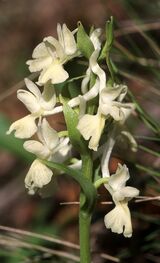
The Roman Orchid is the national flower of Liberta.
Demographics[]
The Libertan Census Administration estimated Libertas current population to be around 3,000,000 people in 2013. Since then, the Libertan population has not grown nor shrunk, it has instead stayed extremely stable at around 3,000,000 people since 1989.
There are a total of 12 districts in which 3 million people live in total. There are a total of 197 neighborhoods in the City of Liberta with the largest district Eode, with 41 neighborhoods, and 869 thousand inhabitants.
Liberta is the 135th most populous country and is the only nation that hasn’t grown nor shrunk by population 28 years in a row.
According to a survey in 2014 2% of citizens identify themselves as LGBT, while 98% identified themselves as straight. This is an increase of 0.02% since 2009.
Language[]
English is the de facto national language in Liberta, although Latin is still the only official language. English was made a national language in the 19th century, because of the quick shrinking amount of Latin usage. Although Latin has an official recognition, it isn’t widely spoken, only 1.3% of Libertans can speak Latin fluently, and around 16% of Libertans know more than a sentence in Latin, this is usually the national motto (Libertas. Scientia sit potentia). The second most common language is Greek, which only about 0.03% of the population speaks fluently. The large and wealthy education system in Liberta makes it the worlds single the best country by Literacy rates at 100%. This is maintained with foreigners by literacy checking immigrants. While illiterate immigrants aren't denied citizenship, they are forced to take a crash course in English to prepare and introduce immigrants to Libertan Society.
Religion[]
The practice to confuse Motusism with the modern-day Libertan relationship and practice of religion is relatively common, since Motusism does originate from Liberta, it’s, in fact, the only religion native to Liberta. However, this confusion does not very well align with the general population of Liberta. Only around 3 percent of citizens are identifying themselves as Motuses, while 96 percent are irreligious. So although Motusism is the largest religion in Liberta it is not dominant.
Government and politics[]
Constitution[]

Map of Libertan Goverment System
Libertas government is based on the Libertan Constitution, also known as the 15 principles. The system was introduced by Cato Aquarius and was first fully executed after his death in 59 AD. The actual Constitution is in fact much longer than the 15 principles, the 15 principles are only the first section of the Libertan Constitution.
General Information []
Libertas government is based on trinitarian parliamentary republican system and follows Libertas constitution known as the 15 principles set by the last ruling monarch of Liberta, Cato Aquarius. Liberta is ruled as a trinitarian parliamentary republic, which means that they use the Trinitarian system, that there are 3 heads of government. This was implemented and invented by Cato Aquarius for the purpose to maximize unified satisfaction in the whole country, the trinitarian principle is made to work as inefficiently as possible, not to make one part of the country happy and the rest shattered, but to encourage compromises. It is generally criticized for being inefficient and slow, like the European Union, however, it is also often being credited as one of the most stable and fair political systems in the world as the inefficiency has resulted to compromises between previously split parties with different ideologies. This has resulted in a 93% approval rating of the general goals set by the Libertan State. For a current issue either on a local or national level to be made into a law or a proposal either the 3 heads of the state known as the Potissimuses or the equivalent to US house of representatives and the Senate, the Hall of Decision and the people in it, the Cardinalises to make a formal proposal. While Potissimuses can create Formal Proposals right away, the Cardinalises can not. For Cardinalises to be able to create a formal proposal they first need to hold a vote on an issue. An issue is an acknowledgment of a [usually] local or [unusually] national problem. Issues can only be brought up by a representative of a Neighborhood. A representative is a person representing the neighborhood they are living in and are elected by small, local elections held parallel to the election of the Potissimuses and Cardinalises. After an issue has been stated the Cardinalises can vote on whether or not to make the issue into a Formal Proposal. If the issue is accepted, it will be made into a formal proposal, with cost and plausibility take into consideration. This is made in collaboration with the Ministry of Economy. After the Formal Proposal is done it is again voted on in the Hall of Decision, if the issue is accepted [usually] it gets sent to the National Supreme Court, now with judicial plausibility taken into consideration. After the Formal Proposal has been [potetially] modified it gets sent to the Constitutional Court. It is the indulged by the Court to see if it violates the Constitution of Liberta. After the issue has been checked and accepted in the Constitutional Court the Potissimuses, along with the Courts of District, law enforcement, and other authority are informed. After that, the Formal Proposal is finally made into a law. The Potissimuses go thru the same system except that they do not need an issue to be able to create a Formal Proposal. If an executive order is made, however, officials vote on the executive order, if accepted [usually], military and agencies are informed.
The cardinalises are 197 men and women together assembled in the “hall of decision” or chamber and vote on different issues presented by a representative of a district. These issues are passed to a representative of a district every two months by local citizens.
The cardinalises are elected on the exact date that the three potissimuses are elected on. These cardinalises come from different districts, where they are voted upon by local residents in that very district.
Every cardinalis and potissimus must identify themselves to one party, the largest parties in order are:
![]() Prosperity Party 39.8% (Social Liberalism)
Prosperity Party 39.8% (Social Liberalism)
![]() Liberta First 33.2% (Social Conservatism)
Liberta First 33.2% (Social Conservatism)
![]() One Liberta 17% (Civic Nationalism)
One Liberta 17% (Civic Nationalism)
Wing Party 4.3% (Conservatism-Traditionalism)
National Liberta 3.7% (Nationalism)
Other 2%
Sub-Divisions[]
There are 2 provinces in Liberta, The Populated Province and the Nautical Territory of Liberta.
There are 12 total districts which make up the city of Liberta, all with, to some extent, political power. These districts have been created due to the historical development in the city, the Vetus Oppidum, or now known put as simply "Old Town" is the oldest part of the city, it was the first landmass that was built by Ace Aquarius. It is also the most structurally sensitive part of the city, massive renovations under Vetus Oppidum to reinforce the structure and foundation have been in operation since the 1990's.
In Vetus Oppidum the City Hall is located, as well as Cato's plaza, the Domus Potissimuses (house of Potissimuses), as well as the Domum magnam de iudicium. Vetus Oppidum houses 8 neighborhoods, however, few people actually live in Vetus Oppidum. Surrounding Vetus Oppidum is four younger districts known directly as the Latin words for north, south, west, and east, Septentrio, Meridies, Occidens, Oriens. These districts were built a neighborhood at a time from the 1st to 6th centuries.
Septentrio is the smallest district within the central districts and consists of six neighborhoods. Septentrio is most famous for being the home of Kolm University which was built during the Libertan Apathetic Years. People living in Septentrio are called Septents and their baseball team is called Septentrio Scorpions. West of the Septentrio district is the Occidens district.
Occidens is made up of 7 neighborhoods, Occidens, commonly incorrectly pronounced "OCK-SEE-DENS", pronounced "OCH-EE-DENS", is most famous for having the world's largest fishing market, Marinus Mercatus, the largest outside all-year open spa and public bathhouse in the world, and for having the Water Palace, in which public fountains still are open and functional. The people living in Occidens are called Occids, which are usually picked on by rival sports names by calling them "Accidents" due to the similarity. Their baseball team is called the Occidens Ocelots. Southwest of Occidens is the district Meridies.
| Ministry | Minister | Appointed by |
|---|---|---|
| Ministry of Law |  Cario Ianuarius Cario Ianuarius |
Lawson Guus |
| Praesidium de Patria |  Daniel Jones Daniel Jones |
Marino Laurens |
| Ministry of Foreign Relations |  Sanna Gennadius Sanna Gennadius |
Gaius Destin |
| Ministry of Economy |  Modestus Corbulo Modestus Corbulo |
Lawson Guus |
| Ministry of Education |  Caesia Gemellus Caesia Gemellus |
Marino Laurens |
| Ministry of Health |  Dave Macrinus Dave Macrinus |
Gaius Destin |
| Ministry of Energy |  Fadia Larcius Fadia Larcius |
Lawson Guus |
| Ministry of Labor |  Stalagmus Tuccius Stalagmus Tuccius |
Marino Laurens |
| Ministry of Surroundings |  Citro Arpagius Citro Arpagius |
Gaius Destin |
| Ministry of Cultivation |  Thomas Johnson Thomas Johnson |
Lawson Guus |
| Ministry of Commerce |  Ergalisus Trebellius Ergalisus Trebellius |
Marino Laurens |
Meridies consists of 7 neighborhoods and is famous for having the free hospital of Herodes Atticus, which allows free healthcare for poor people around the world. Their work has largely moved toward other countries since the re-entry project was started by the Public Welfare Fund in association with Quod fiscus quia quod miser. Meridies also houses many charitable organization offices. People living in Meridies are called Merrians and their baseball team is called the Meridies Moose. East of Meridies is the district Oriens.
Oriens is the largest central district in Liberta and consists of 11 neighborhoods. Oriens is famous for its restaurants, small plazas, and picturesque streets. Oriens is also well known for being used as a metaphor for upper-class society, a common misbelief is that there is a quite small upper-class closed of secret society, which is not true, however many of the most influential people that come from Liberta live in Oriens, like Eadric Zacharyval, the president and founder of GERC with an estimated monthly income of around 46,875 EQD. Oriens is often nicknamed as the Beverly Hills of Liberta, and although Oriens technically isn't another city like Beverly Hills, the similarities in income are certainly visible. A stereotype, originating in Septentrio is that Orienses are obnoxious, snobby, and rich. And while the median income in Oriens certainly is higher than the Libertan average, it is estimated that only around 15% of people living in Oriens have a higher income than 10 thousand EQD. These people that are in the 15% usually live in the neighborhoods Plautius and Dacien. People that live in Oriens are called Orienses and their baseball team is called the Oriens Otters.
The district Eode stretches along the western coastline. With 41 neighborhoods in total, it is the most populous district in the whole City of Liberta. Eode was, like the other outer districts constructed a neighborhood at a time during the 500-1800's. Eode houses 29% of the City of Liberta's population which is around 869 thousand people. It is most commonly known for its distinctly western architecture, the NALCAMM plaza, the microride service, Gaius Square, and it's resemblance to central Manhattan. Eode is where amusement parks, hotels, Liberty Tower, and other tourist attractions are located. People that live in Eode are called Eodes and their baseball team is called Eode Eagles. The district Pascoe stretches along the southeastern coastline of Liberta. Pascoe is the second largest district after Eode, in area and population. With around half a million people living 31 neighborhoods Pascoe is a large and crowded district. It's also the home of several factories of companies like GERC, Amnac, and Speedster. Although these factories are a factor in general social-anxiety, they are considered to hold some form of historical value as they represent, according to many, the industrial powerhouse that Liberta is. However, in later years the Ministry of Economy has enforced a 5-1B emission standard that factories in Pascoe now have to follow, partially because of the large part of the population living in Pascoe. The factories, however, are considered to be cleaner than factories near urban centers in the US and Europe[2], with a standard emission in GERC's steel mills of 1.2 tonnes per tonne product. Pascoe is also often considered the commercial center of Liberta as many Malls, Shopping Centers, and headquarters to common technology companies. People that live in Pascoe are called Pascans and their baseball team is called Pascoe Penguins.
Gaius is the third largest district and it neighbors Octavio to the east, Cato to the south, and Septentrio to the west. Gaius was named after the philosopher Gaius Gorgonius, which also named the university Gaius University. 9% of the population of the City of Liberta lives in Gaius, which is roughly 270 thousand people. A common misbelief is that Gaius Gorgonius was born in the district of Gaius, which he was not. Gaius is known for having the largest Baseball field in Liberta, Gorgonius Stadium. They are also the home of Gaius University and Liberta's largest school, Nicodemus School. People living in Gaius are called Gaiuses and their baseball team is called the Gaius Geckos.
Konstantin is a northern district which neighbors Octavio to the east, Eode to the west, and Occidens and Septentrio to the south. Konstantin is named after the poet and son of Cato Aquarius, Konstantin Aquarius. Konstantin is most famous for being the birthplace of the ITO which now spans over 102 nations worldwide and is largely considered to be the largest common organization for cooperation in trade. Konstantin also contains the largest amount of temples in the whole City of Liberta. About 7% of the total population of the City of Liberta live in Konstantin, which is around 210 thousand people. People that live in Konstantin are called Konstants and their baseball team is called the Konstantin Killer whales.
Octavio is the northernmost district in the City of Liberta and has the Sorting-Number "10". It neighbors Gaius to the west, Gaius to the south and Septentrio to the south. Octavio is home to several agencies working with classified information such as the HIA and HSA. It is also the home to many embassies. Around 204 thousand people live in Octavio which is around 6,8% of the total population of the City of Liberta. People living in Octavio are called Octavians and their baseball is called the Octavio Owls.
Cato is an east district with a population percentage of 6,6% of the population of the City of Liberta which is around 198 thousand people. Cato is named after the last monarch of Liberta, Cato Aquarius. Cato is the second smallest outer district and the smallest east district with 16 neighborhoods. Cato is where most small universities are, in fact, many calls the inner neighborhoods of Cato "the Giant Campus" as supposed to the sheer amount of Universities that are placed in Cato. People that live in Cato are called Catans and their baseball team is called the Cato Cheetahs.
Martel is the smallest outer district with 16 neighborhoods, one of the "neighborhoods" is the Martel Port. It is the largest harbor in Liberta and is where 87 percent of the total national imports. Large shipping companies like Speedster have their headquarters located in Martel and foreign companies like Maersk have a shipping hub in the Martel Port. Because of this, the Martel Port is often valued as the single most valuable location in Liberta for economic growth of the Nation. Only around 186 thousand people live in Martel, which is about 6,2% of the total population of the City of Liberta. The number 1 reason that people move to Martel is that according to the Economic Growth Study made in 2012, the economic attraction to the harbor. People living in
Martel are called Martellans and their baseball team is called the Martel Manta Rays.
Military[]
The first national military force was the Libertan navy, founded during the 3rd century. Its main mission was to protect Liberta itself, rather than act with offensive tactics as it was prohibited by the 15 principles. Until the 17th century, this was the only military force other than their coastguard that Liberta had. In 1622 the Libertan Armed Forces was established by the then ruling N-C-W governance, this was to differentiate the previous split sections of the Libertan Navy known as The Naval Group and The Land Group. In 1937 the Libertan Air Forces was founded out of fear of the rising Nationalism in Europe, mainly Germany and Italy.
As a rolling force of independence rinsed over Liberta during the 4th century, the country was left with a large military force along with the positive eye of the public. Ever since, Liberta has favored military advancements in technology. As Liberta and Liberism heavily encourages independence and self-sustainability the military has played a very important role in Libertan society as the key defender of Liberta.
Today Libertas army consists of The Libertan Navy, Coastguard, Air Force, and Armed Forces. In total the Military employs 120,000 people, the Libertan Navy employing roughly 60,000 people, The Libertan Coastguard Employing roughly 15,000 people, The Air Force employing roughly 20,000 people and the Armed Forces employing roughly 25,000 people.
While remaining a neutral country, the Libertan government is the highest spender of any country in the world by percentage of Gross Domestic Product, currently 5% or 32,500,000,000 of 650 billion. While keeping defense-oriented, the Libertan Military isn't afraid to show off. It regularly performs exercises within national nautical boundaries and often showcases technology to other countries. While the military only employs roughly 60,000 people it has a technical advantage, often considered the single most technically advanced armed forces within the international stage.
Ministries[]
Libertan Ministries are the first sub-divisions of government, alongside Hall of Decision and Potissimuses House. Ministries are each governed by a minister, appointed in the following order by each Potissimus. In total the Libertan Government has 11 Ministries, 2 Agencies, and the Control Operative Agency.
Infrastructure[]
Transportation[]
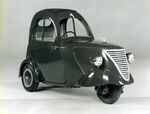
Fierre's F1 revealed in 1956. It was originally sold for $200 EQD.
Transportation in Liberta is managed by the Ministry of Transportation. The most common form of transportation in Liberta is bicycling.
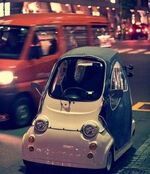
Pedestrian streets are common in Liberta and take up around 85% of all streets in Liberta. Civilian ownership of a car is illegal, as only potissimuses and agents from the Secret Agencies are allowed to own one. The reasoning behind this ban is that the Ministry of Transportation claimed that “not only are motor vehicles loud and dangerous they are also a great potential threat to the city’s foundation because of the weight of the vehicles”. Emergency vehicles such as ambulances, firetrucks, and police cars are allowed to drive, however in their own designated “fast lanes” [except for police cars in a chase]. Though civilian car ownership is illegal, there are several long routes stretching on the defense-walls, these are mostly used by farmers to transport their goods, therefore car ownership is not illegal for farmers.

Ford Urban.
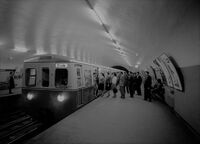
The First Ever Photography taken of the Liberta Metro. This image was taken on the opening in 1968.
E-cars
E-cars where the governments answer to the public outcry over slow mobility around the city. E-cars are electric one/two seated microcars with a motor capacity under 50kW. First introduced in 1956 and pitched by Jerry Ross in 1955 the first ever produced E-car
was the Fierre 1. The Fierre 1 was released in 1956. The Ministry of Surroundings complained that the loud heat engines would cause unimaginable stress levels. Because of this, the Ministry of Transportation required E-cars to be electric. The E-cars were not produced by the government, but by private-owned companies, such as Fierre. The Fierre 1 is often called the father of all E-cars in Liberta. On the launching day of May 1st, 1956, the Fierre sold over 13 thousand F1’s. An F1 was priced at $200 EQD, which is around $2000 EQD today. The F1 was an immediate success, but it wasn’t until 1967 that a competitor arose to the scene. Today there are over 20 different brands selling E-cars and they are now common to see on the streets of Liberta. American Ford also made an E-car specifically for Libertan customers, which was the Ford Urban.
Public Transportation[]
A demand for Public Mass Transportation emerged in the early 60's, as the population of Liberta steadily grew. The demand was justified by the Ministry of Transportation in February of 1962, as they revealed plans for a Rapid Transport System. Several suggestions were pitched to the Ministry, which finally settled on a subway system.
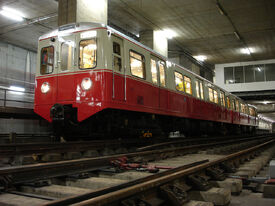
The Current GERC M1 Liberty Class. I Car, refubished in 2008.
Construction of the railway began in 1965 with the Circle Line, which went around the inner Districts in a circle. Construction of the underground tunnels was difficult because of the way that Liberta is constructed. The City of Liberta is laying on top of many layers of 1.5x1m large stone blocks laid in a circular pattern. For an underground tunnel to be constructed, large trenches needed to be dug in the middle of streets. The Ministry came up with a clever way to construct the tunnels, however. First, trenches would be dug in streets, then on the bottom of the trenches rebars would be placed on top of large I-beams, set 3 meters apart. The combination of I-beams and rebars were supposed to spread out weight, which they did. The I-beams and rebars were then held together by cement, creating a stable foundation on which to lay the track on. The chosen track gauge was the Standard Track Gauge.
The Circle Line was constructed during 1965 until 1967. The Metro was officially open to the public January 1st, 1968. As the ridership increased in early 70's The Ministry of Transportation announced two new lines to be built, the C- or Connect-Line and the G-Line. The construction of these Lines began in 1971-and-2 respectively. Originally the Connect Line was named the Martel-Pascoe Line[3] until 1989. The C and G lines were completed in 1974.
Eode had experienced a population boom, with an increase of 75%. This lead to cramming in transportation, as the current bike lanes in Eode couldn't support the increase in transport. At one point in 1978 bike lanes and pedestrian streets were so worn down that large cracks that were the size of cars were scattered across the streets of Eode. This caused the Ministry of Transportation to rapidly construct a new subway line, the aim was originally not to improve general transportation in Eode, but to cause a downfall in density in public spaces so that police forces could more efficiently. The E-Line was opened in 1980, with a fall in crimes committed the same year.
In 1996 the O-Line was constructed and opened to the public in 1998, due to increased overcrowding on the Circle-Line, since many daily commuters using the Circle-Line came from Konstantin, Gaius, and Octavio. This resolved many problems related to wear, such as overfilled trashcans, rodents, sanitation problems, and safety concerns. However, many daily commuters using the G-Line accuse the O-Line of overloading the G-Line.
In 2004 the Ministry of Transportation announced a new line to be built connecting the R-Line to the Circle-Line, to increase capacity and to make it easier for commuters traveling with the R or Circle Line. In late 2004, it was announced that the new line would also connect to the C-Line, enabling for even easier transport. The M-Line started construction in early 2005 but was delayed significantly by the Tropical Storm Delta. In late April of 2006, the M-Line was opened to the public.
Today the Liberta Metro is operating 41 stations and 56.9 kilometers of track. With 2 million daily commuters.
Economy[]

Front side of the 10 Equal Dollar.
Liberta has a stable and high-tech economy and enjoys great wealth per capita. Liberta is home to many large corporations including GERC (Steel and Robotics), Amnac (Pharmaceutical industry), Hayden Reid (Shipbuilding), Fierre (Vehicle Manufacturer), Johnson Floyd (Aerospace manufacturer), and Speedster, Inc.Container Carrier). Liberta also has one of the most powerful economies in the world, and 5 of the best one hundred universities in the world. But by far, the most important sector of the economy is the manufacturing of steel, marine biological instruments, pharmaceutical products, biotechnology and chemicals of different sorts. Taxation is one of the highest in the world at 30 percent, and due to the Liber-Interest Act of 233, Libertan companies must stay Libertan, preventing corporations to migrate to another country. This has lead to large taxation profits for the Libertan Government, increasing welfare exponentially, this phenomenon has become known as the "Well off boom", which began in the 1940's with the manufacturing of supplies for the allies in World War 2.
Education[]
| Grade | Amount of points |
Comment |
|---|---|---|
| Ⓐ | 1100-1300 | Pupil is doing great in school, will move to more advanced education. |
| Ⓑ | 900-1099 | Pupil is doing very good in school, will move to advanced education. |
| Ⓒ | 700-899 | Pupil is doing good in school, will advance. |
| Ⓓ | 400-699 | Pupil is doing fine in school, will advance slightly. |
| Ⓔ | 100-400 | Pupil isn't advancing in education, will remain on same level of education. |
| Ⓕ | 0-100 | Assistance to pupil is required, possibly due to psychological challenges. |
The education system in Liberta is completely free of charge and obligatory from 5 years of age all the way to University, because of this system Liberta has the highest literacy rate, number present in educational facilities per day on average and graduation of any country. There are 16 universities completely free of charge owned and operated by the government and five universities owned by private institutions. The primary school selection is based on learning capabilities by pupils. Pupils with a faster learning capability receive an education customized for them, while pupils with a slightly slower learning capability receive an education customized for them. This system has been criticised for “separating children with lower skills of learning”, however, this system is widely effective compared to traditional education systems. Each year all students receive the "Grade Test", which features 100 questions from each subject. The test is done during Every English lesson for 2 weeks and determines which customized education the pupil receives. Each question is worth 1 point, which if all questions are answered correctly would accumulate 1300 points. Students above D will advance into new classes customized by the pupils performance on the test, E Students will remain in the same grade for 2 months where they will attend Crash Courses on subjects and do the test again after 8 weeks. This will be repeated until students advance to D or above. Students with an F most likely have psychological challenges and will therefore receive additional assistance, and will be placed in small classes with other students with similar grade scores. The levels of education F pupils receive are very personalized, so that they may advance in their "own speed". Due to this separation of children, all children are to attend social classes which are 15 minute lessons scheduled at the end of each school day, to learn how to behave in public spaces.
All of this is regulated by the Ministry of Education, which receives an annual budget of around 800 million equal dollars per year. Because of this large spending the schools, upper secondary schools, higher education facilities, and universities are well organized, perfected, and ultimately customized.
Today Liberta plays a leading role in the international community as the "capital" of education, accepting roughly 60,000 foreign students. Kolm University, Gaius University, School of Cato, LUIT are all currently Top 20 Universities, contributing to the large international community in Liberta. Because of the concentration of prestigious universities in Liberta, local citizens are generally looked upon to have great outlooks. As all citizens have access to university degree education, Liberta has the highest rate of university graduates per capita in the world.
Culture[]
The Libertan culture originated from the late Archaic period in Greece since that is Ace Aquarius, the founder of Liberta came from. The Libertan culture later changed into a mix between Scandinavian, Greek, Roman and Spanish culture, mainly however greek. Libertan became a separate distinct culture 19 BC when the Scandinavians, Greeks, Romans, and Spaniards together mixed their traditions with the greek-alike society. During the 20-21st centuries, Libertan Culture has had a strong influence of typical western cultures, mainly American Culture. As Liberta westernized during the 20th century so did its culture.
Architecture[]
Libertan apartments were standardized in the 300s by the architect Apostates. While Roman and Greek apartments weren’t heated and damp, Apostates inventions and architectural breakthroughs made Libertan Apartments and living conditions modern by today’s standards. Apostates began his research in living space heating year 287. Since he knew heat traveled upwards, he came up with a centralized source of heat in the basement of each apartment. The central heating source would be a steel casque sloping down, a funnel if you will. In the middle of the funnel a small circle was placed with walls slight taller than the casque itself so that no oil could leak inside. A small hole was place on the bottom of the walls of the circle together with a strangler, a small device that regulated the amount of oil let into the circle. In the middle, a small bulge was put where the fire was to burn from. Inside the bulge a small pipe was put, because the oil level was higher than inside of the circle, the oil would be pushed up onto the top of the small cylinder, so that the fire received fuel. Just over the bulge two rough cut rounded flint stones were put, in contact. One stone however, was able to be spun using a rotary handle. These flint stones were put just over the bulge so that small fire sparks could reach the oil to start a fire. The smoke and warmth would then travel up clay covered stone pipes, the clay used as Insulation. The pipes would spread out to every apartment room, on the side toward the wall there would be no insulation, so that the heat could enter the rooms.
Philosophy[]
Liberta is most famous for its philosophers and philosophy. As Liberta was reformed by Cato Aquarius into a society centered around philosophy, education, and science.
Standards[]
The Libertan culture is usually described by its standards, that mostly revolve around the concept of self-sufficiency, that the nation itself should not be in need of any other nation. This is often reflected in politics, such as the denial of joining NATO. Although Liberta is often seen as a large political source of influence in the international community, the concept of self-sufficiency is still a root in Libertan Standards. With a Roman Greek cultural background, the Libertan Culture is heavily influenced by the culture of Roman Greece along with Classical Greece. The other common standards of Libertan culture is that Knowledge equals power, thereof that education equals certain power. The higher education you have the better jobs you equip, just like in most other cultures. However, a Libertan upper-class child and a Libertan working-class child have about the same chance of entering a good university, because of the Libertan Constitution which grants free university education to the general public. Another common standard is that freedom equals priority. This bears the meaning that freedom should, to the fullest extent, be granted at [almost] any given time. This however is a loose term.
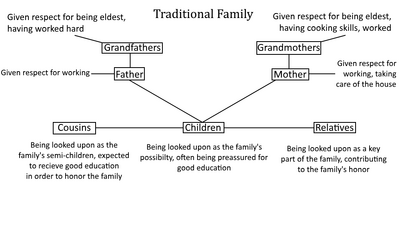
Mothers are also expected to have a half-time job, fathers are expected to help and assist with housework.
Family[]
Libertan culture is not family-centered, it rather applies more strictly to education. However, despite this family values in the Libertan society and culture exist. In a traditional Libertan family the Grandparents have the uppermost respect. Since grandparents have lived the longest, experienced the most things, have had to make the most choices they are generally thought of as being superior in family. The Mother and Father are looked upon as the key parts of the family keeping the family together, while children are expected to get a good education in order to contribute to the family's honor.
Generally, families are expected to have no more than two kids, having more than this number is seen as unorthodox. Many families have no more than two children since fathers often work up to 8 hours a day and mothers 5 hours in addition to housework.
Food[]
Olives together with fat milk have for a very long time been associated with the Libertan cuisine, it was first introduced by Cato Aquarius, who loved taggiasche olives. The traditional food of Liberta usually consists of fish, meat or chicken together with a wheat product or potatoes, and with olives and usually tomatoes and cucumber. The traditional dishes have been heavily influenced by the lack of fertile soil. Therefore, offshore-based ingredients such as fish, shellfish, and other aquatic craniates.
Literature[]
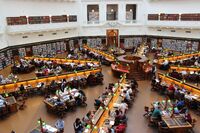
The National Library of Education.
Literary works have been made by several famous Libertan poets such as Cato, Quentin Salvadore, Gaius, Konstantin, and Lucjuzs Octavio. Many great poets wrote books during the Libertan Apathetic years. Works such as “Where we originated from”, “Our beloved freedom”, “Humans and how we control them”, “The understanding of this world” shaped early European poetry and “A story of origin” laid the foundation of the theory of evolution together with Rusell Wallace.
Media[]
Broadcasting television quickly became a standard in Libertan society and was experimented with in Libertan universities, one of the largest broadcasting networks in the world, NNS, originated in Liberta and are still locally operating. Today, there are 5 major newspaper publications in Liberta, The Stoneman, Liberta cotidie The Physicus, The Daily Poster, Liberta Today.
The media university of Liberta has become the “heart” for indie-film creators to seek an education and many films were shot partially or completely in Liberta, for example, the movie “The people of the ocean: a 1961 story” was entirely filmed in Liberta, since it was about Libertans as a people. Another famous example is "Her name was Love".
Anthem[]
The National Anthem of Liberta, People of the Sea was adopted in 1819. People of the Sea was composed by Ludwig Heirtcz in 1801 but was officially adapted in 1819 by the Libertan Government. From 100 CE until 1819 the anthem Liberty in Our Name was used. Liberty in our name was not officially recognized however, but was commonly agreed to be the anthem representing the country.
Liberty in our name[]
Oh Liberta (x3)
United we stand together
Under flag we must confess
Fighting for gold and magenta
Standing with Liberty behind
Forced away from brutality
United we stand together
People of the Sea[]
Standing proud until death
We shall stand alone forever until death
For it is with mighty union we stand with Liberty (O' Liberty!)
For it is with mighty union we stand with our peers (Our Peers!)
Never let go of the sight of freedom and liberty
For it is with mighty union we stand with pride in our blessed hearts (Blessed!)
Health[]
Libertas current life expectancy is 82.5, second only to Japan. The factors leading to higher life expectancy are all found in Liberta, the Ministry of Health offers free healthcare, including dental care, and check-ups are mandatory every 6 months, and while this is often seen as too frequent it is believed to have significantly risen the life expectancy. Fish, wheat, and generally fatty foods are common ingredients in the Libertan cuisine, often toppled by blueberries, this is also believed to have helped increase life expectancy. Health and the body’s fitness has been a common subject of debate in Liberta for hundreds of years, going to back to the 4th century, where body styles where debated. Generally, fitness plays an important role in Libertan society and has for centuries.
What is expected by not only us but the individuals around us, is our bodies. For, it’s rather obvious that the embodiment of our souls is our bodies and the outer, descriptive key for the ones who do not know us.
For they see us only by the shells of our true selves, determined to determine what to expect of us, and before we know it, they believe they know us better than ourselves. It is no use fighting this, standing up, protesting, for why protest when the key is inside yourself?
It is therefore natural to be determined to have a fit, well, and healthy body, capable of humane tasks, the ones that were determined for us, by us, not by ourselves, but by the ones before us. Our bodies determine what we receive, and are expected to behave like. Our bodies determine not what we want to achieve, but what we can achieve. It is therefore obvious to metaphorically reach for the strong body, since you are at the same moment, building a stronger self.
—Chapter 2, Humans and how we control them, Euclio Maecius.
Holidays[]
A significant majority of Libertans still celebrate many holidays, often going back one thousand years.
| Date | Holiday | Cause | Vacation? |
|---|---|---|---|
| January 1st | New Year's | Celebration of the New Year | Yes |
| January 22nd | Defense Day | Homage to the Libertan Military | Yes |
| February 2nd-4th | Days of Veterans | Homage to Veterans that served the Libertan Military | Yes, only for Veterans |
| February 29th | Little League Season Start | Celebration to the start of the Little League Baseball Season | No |
| Third week in Mars | Spring Week | Celebration of the coming of Spring | Yes |
| March 29th | End of the Little League Season | Celebrating the End of the Little League Baseball Season | No |
| May 4th | Start of the National Baseball Championship | Celebrating the beginning of the National Baseball Championship | Yes |
| May 23rd | Ace's Day | Celebration of the founding of Liberta | No |
| May 24th | National Day | National Day of Liberta | Yes |
| June 8th-August 8th | Summer Break | Summer Break | Yes, children receive 8 weeks of Summer Break, Adults may use their 6 weeks of vacation at Summer Break |
| September 4th | Win in the Battle of Unda | Celebrating the Libertan's Army win against the Byzantine Navy during the Battle of Unda in the year 524 | No |
| Last week of December | Jolly Week | Also called Christmas Break, Jolly Week celebrates families and relatives coming together for the last week of the year | Yes |
| December 31st | Passing | Celebration of the current year | Yes |
- ↑ http://tos.org/oceanography/assets/docs/23-1_mohn.pdf
- ↑ http://ieaghg.org/docs/General_Docs/Reports/PH3-30%20iron-steel.pdf
- ↑ Note that this was before the connection to the E-Line in 1996
| This article is a part of the Liber Ominverse, For a complete list of articles, go to Category:Liberta. |



